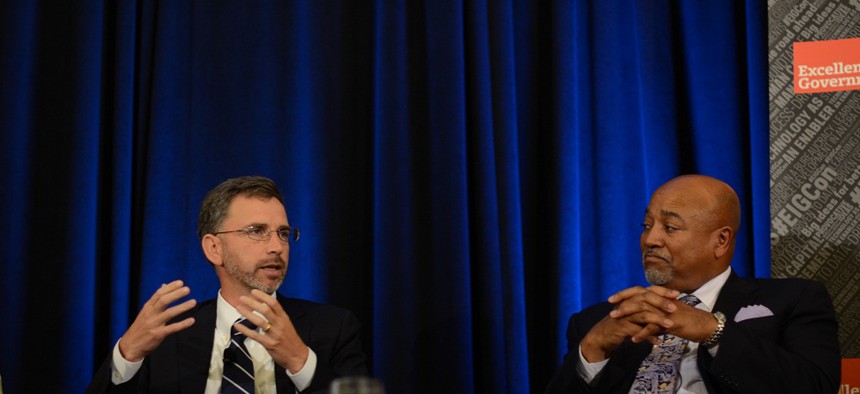
Image by Caitlin Fairchild
The 3 Keys to Motivating Feds During Tough Times
GSA Administrator Dan Tangherlini and other federal leaders discuss how to motivate feds when the going gets tough.
"The job of federal manager is tough and getting tougher," concluded John Palguta, President of the Partnership for Public Service and moderator of a panel entitled "Leadership Beyond Limits: Breakthrough Practices for Increasing Employee Motivation" at Excellence in Government Live on Sept. 6.
With a focus on the best methods to inspire and encourage agency employees, the discussion was designed to enrich audience understanding of the connection between leadership and employee motivation and how to drive success in your agency. The audience was in search of concrete tools and techniques to bring out the best in their employees while improving their agency's Effective Leadership score on the Best Places to Work index. Palguta was joined by:
- Reginald Wells, Deputy Commissioner, Office of Human Resources, Social Security Administration
- Peggy Focarino, Commissioner for Patents, U.S. Patent and Trademark Office
- Dan Tangherlini, Acting Administrator, General Services Administration
- David Dye, Director, Deloitte Consulting LLP
Key takeaways:
-
Remind employees why they came to work for government in the first place.
- Wells: "With the kinds of tensions and pressures that all agencies are under these days, there is that tendency for people to become discouraged, for morale to drop and perhaps a loss of engagement on the parts of individuals or whole units of your organization and you really can't afford that. We're all in this to make a difference in the lives of people, we wouldn't have come to government...if that wasn't a primary motivation...It's extremely important that we both nurture the engagement of folks and try to improve upon it...Remind people why they came to this work. We have found that is a major, major incentive.
-
Connect employees to the mission.
- Tangherlini: "I would say that the correlation, based on nothing other than my own experience, is one to one. Agency effectiveness in delivering mission and employee satisfaction are directly correlated. If you have an agency that is not particularly effective and has a less than fascinating mission you can probably get people to be satisfied working there but it's going to cost you a lot. It's going to require an awful lot of managerial gymnastics. I think the real issue comes down to figuring out ways that you can maintain sustainable connections between the employees and the work, the employees and the mission, and giving them some sense that, if the place is effective, it’s because they made some kind of contribution to that outcome."
-
Mentoring and coaching are key.
- Focarino: "We're focusing on the key role of coaching and mentoring because frankly a person's connection to their first line supervisor really dictates whether they stay in a job or they leave…That first line supervisor has to know that they have a huge influence and we need to give them the tools to coach and mentor and deal with performance issues early and have the tools that they need to hold people accountable. They're responsible for a bottom line but they're also responsible for inspiring people to do more than the bare minimum."
The panel concluded that, even in tough times, focused leadership can maintain and even increase employee motivation, engagement and organizational effectiveness. It isn’t easy and there are no guarantees in the current environment of rising workloads, decreasing resources, increased retirements and declining public support. But research shows that success in this regard is not accidental--its linked to specific management actions.
The good news? While successful leaders have always managed to figure out how to engage their employees, they are now increasingly focused on doing so and sharing the lessons learned.
What are you finding to be the keys to employee engagement?
Want more Excellence in Government? Follow us on Twitter | Facebook | Google + | LinkedIn






